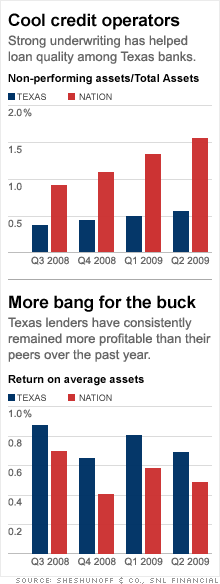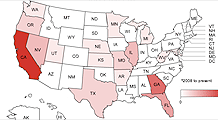Don't mess with Texas banks
A strong local economy and healthy profit margins add to the Lone Star State's allure. No wonder all the big national banks want to do more business in Texas.
NEW YORK (CNNMoney.com) -- The old adage that everything is bigger in Texas still seems to hold water --especially when it comes to the business of banking.
Before Guaranty Financial Group collapsed last week, the Austin-based thrift reportedly drew intense interest from lenders and investors across the country. U.S. Bancorp (USB, Fortune 500), Wells Fargo (WFC, Fortune 500) and the private equity pros that bought IndyMac were said to have either bid or consider an offer for its assets. Guaranty was ultimately sold to Spain's Banco Bilbao Vizcaya Argentaria (BBV).
But Guaranty may be an anomaly. Only four Texas banks have failed since the beginning of 2008. And the failure of Guaranty had more to do with exposure to bad real estate loans in California than problems in its home state.
In fact, business has been good for banks operating within the Lone Star State.
In the second quarter, Texas banks reported profitability that surpassed the rest of the country, generating a 0.69% return on assets, compared to the national median of 0.49%, according to a recent report published by investment bank Sheshunoff & Co.
"It is the one area of the country where you could say there is an abundance of interest [on behalf of bankers]," said Brett Rabatin, a senior research analyst at Sterne Agee who tracks a number of Texas-based lenders.
In some ways, Texas seems to have everything a bank could love: a rapidly growing population in need of a place to park their money and a relatively resilient economy that could be among the first to emerge from the recession.
As of July, the state's unemployment rate stood at 7.9%, one of the lowest in the nation. But other recent economic indicators have also been encouraging. Median home prices and sales activity, for example, have both been on the rise this summer, while manufacturing activity has also improved in recent months, according to recent data from the Federal Reserve Bank of Dallas.
That has helped many local banks avoid the hefty credit costs that have saddled so many of their peers across the country -- and ultimately boosted their bottom lines.
Such factors, combined with a tough-but-fair state regulatory regime, have made Texas the destination of choice for the banking industry in the past few years.
Before being acquired by Wells Fargo last fall, Wachovia had planned to build about 250 branches in Texas by the end of next year. Citigroup (C, Fortune 500), Bank of America (BAC, Fortune 500) and JPMorgan Chase (JPM, Fortune 500) all have a significant presence in Texas already, with each boasting several hundred retail locations.
With nearly 640 different lenders operating within the state, overseeing some 5,800 branches, some would argue it makes for a crowded playing field. But that has not deterred many lenders from trying to claim their stake in this lucrative market.
Five of the 28 new banks that have opened so far this year have set up shop in Texas, according to the FDIC. Even veteran lenders, like San Francisco's UnionBank, have taken an interest in the region, reportedly applying for a state charter recently.
But that level of interest cuts both ways, notes Rabatin. With the level of competition so fierce, lenders looking to grow have few options other than stealing market share or through acquisitions.
"The problem is it is so hard to get a critical mass without buying something of decent size, which is why Guaranty piqued a number of peoples' interest," he said.
While Texas may hold the promise of tidy profit margins for banks, some trouble spots still loom for lenders looking to expand their presence there.
The recent decline in the price of natural gas to below $3 has worried some banks with exposure to the local energy industry, while the extent of the fallout in the souring commercial real estate market have also kept some bankers up at night, said Jim Gardner, chairman of Commerce Street Capital, a Dallas-based investment bank.
"It's been pretty good up until now, but we really started seeing a deterioration in commercial real estate beginning in the second quarter," he said. "I suspect that trend will continue for a while."
Still, few expect the industry to relive the painful banking period of the 1980s and early 1990s, which was also driven by a combination of collapsing energy prices and deterioration in commercial real estate values. Between 1980 and 1994, 599 Texas banking institutions failed.
Living with that memory, many bankers took precautions in the years leading up to the current crisis, employing thorough underwriting practices and taking care not to overexpose themselves to the energy industry, said John Blaylock, an associate director at Sheshunoff & Co.
"They were simply much more careful about underwriting loans the last 10 years because of that," said Blaylock. "There are bankers here who vividly remember what happened and are not about to repeat it." ![]()



